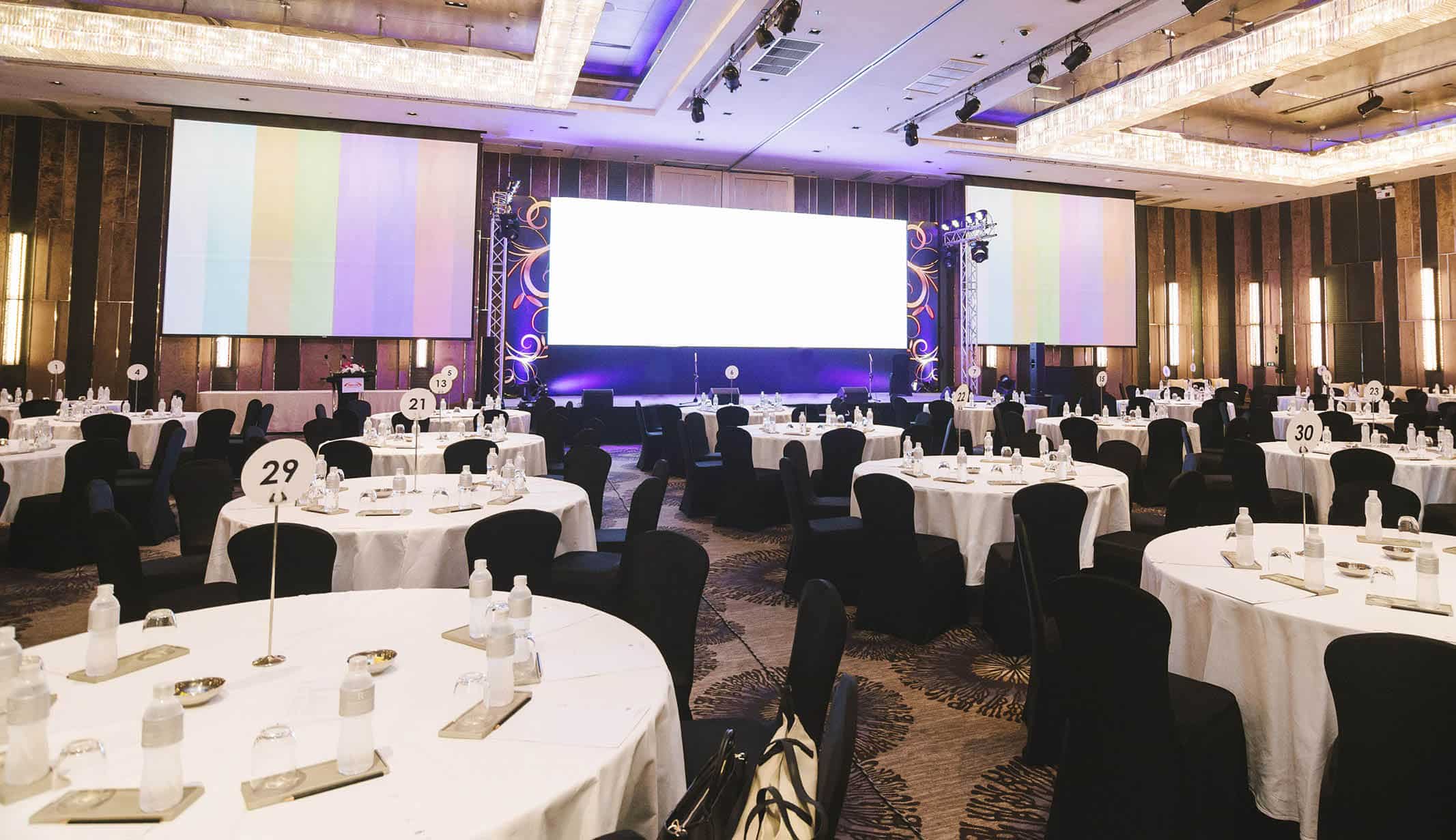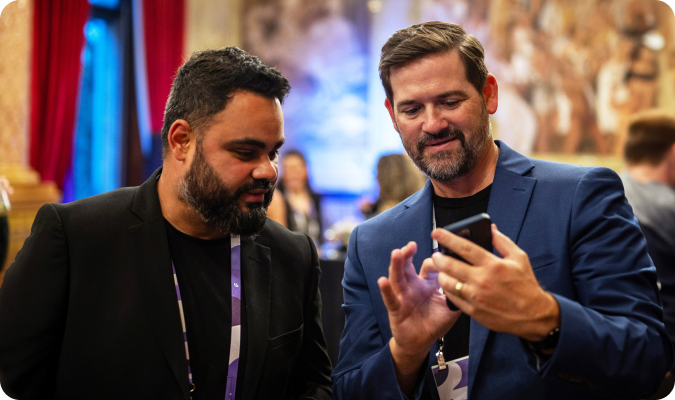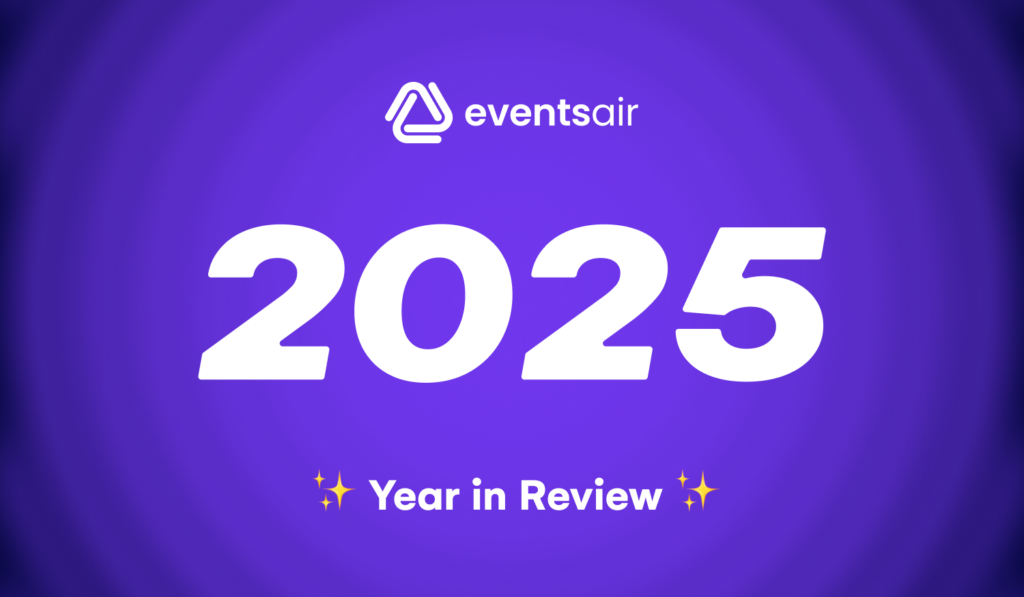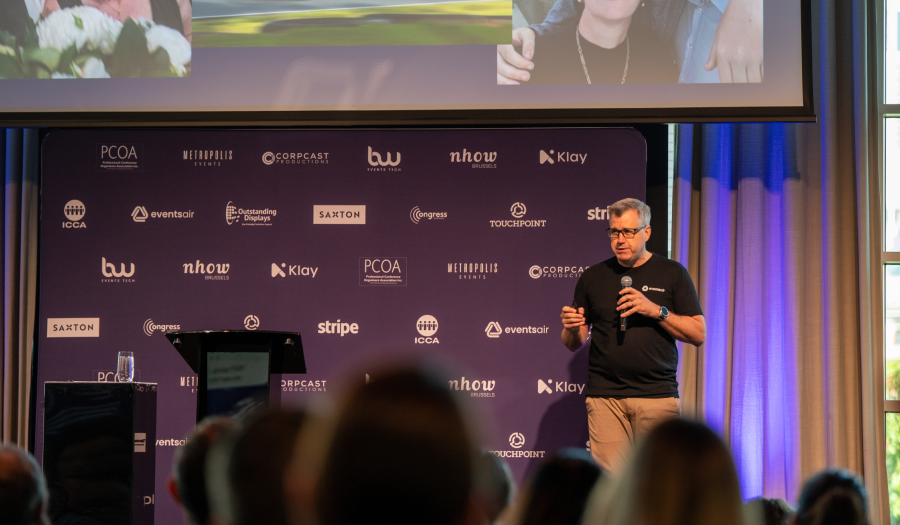
Event staging is a key element of any conference, trade show, or event, as it enables your attendees to experience the atmosphere, aesthetics, and vibe of the live event as you intend them to. Although staging typically encompasses the “physical” features of an event like lighting, background, and audio, it’s not just for physical, face-to-face events!
If you’re wondering how to stage an event for any medium, this comprehensive guide of event staging for in-person, virtual, and hybrid events has got you covered.
What is event staging?
Event staging refers to the process of designing, constructing, and managing the physical and technical elements required to create a successful live event or conference. This typically includes hardware and event tech for the stage itself, such as rigging for lighting and audio, video screens, and projection, as well as design elements for both the stage and the rest of the venue like furniture, decor, props, plants, and costumes.
Why is staging an event important?
Effective event staging can be the difference between a forgettable event and one that keeps your attendees talking for days and weeks after. Here’s why event staging is crucial for in-person, hybrid, and virtual events.
- Enhances the attendee experience: A well-executed stage setup and design creates a visually appealing and immersive environment that captures the audience’s attention and keeps them engaged throughout the event.
- Facilitates effective communication: Proper lighting, audio systems, and visual aids allow event organizers to effectively communicate the event’s message, theme, and content.
- Creates a professional image: A professionally staged event conveys a sense of competence, credibility, and attention to detail, which reflects positively on the organizers and the company behind it.
- Creates atmosphere: Whether your event is a formal conference, rock concert, or more intimate gathering, staging elements like lighting, music, and visual effects play a crucial role in setting the mood and ambiance.
- Direct attention: By using event stage design strategically, event organizers can guide the audience’s attention to specific areas or moments of the event, ensuring the focus remains on the key content, event speakers, or performers for example.
- Aids safety and logistics: Staging also involves careful consideration of safety measures, ensuring that the stage setup is secure and compliant with regulations. Proper planning and logistics management guarantee a smooth event flow, and efficient load-in, setup, and load-out processes.
The main components of event staging
The main components of event staging include:
- Stage and screen
- Backdrops
- Sound
- Lighting
- Seating
In this section, we’ll take you through how each of them might look different for in-person vs. virtual events
1. Stage and screen
The stage and screenplay pivotal roles in both in-person and virtual events – attracting (and keeping!) your audience’s attention to the speaker.
So, you want to make them pop!
In-person events
A well-designed stage creates a focal point, directing the audience’s attention to key content, speakers, or performances. Things like elevation, colors, lighting (read more on lighting below), props, and setup all help to create an aesthetically pleasing scene. Screens facilitate dynamic presentations, multimedia displays, and engaging visuals, enhancing the overall event experience.
Virtual events
Depending on the scale and budget of your event, the “stage” might be as simple as your speakers sitting in their home office with a virtual backdrop showing the event branding, or it could be filmed on a physical set, like the ones we see on TV breakfast or news shows.
If budget allows, you could hire a studio, create your own set, and decorate it to promote your brand and the theme of your event. This works particularly well if you are creating a series of virtual events as you can reuse the set several times over.
2. Backdrop and sets
In-person events
Tasteful vibrant (but not too overwhelming) backgrounds and sets also help to focus the audience’s attention on the stage/screen. Advances in technology have made it possible to use event stage backdrops in creative new ways, like textured walls or videos with designs and images that promote your brand and support the theme of your event.
Virtual events
The backdrop and set for your virtual event are just as important, if not more so than your in-person event as the temptation of distraction is much higher. There are three options for backdrops for online events.
- Green Screen environments: These can add depth to your virtual stage. The background can rapidly be altered to suit different brands or themes and allows people to appear to be sharing a space when, in fact, they are miles apart.
- Printed or digital backgrounds: This adds consistency to the presentations across the event, and it is a great way to promote your brand.
- No background: If you’re unable to create a backdrop of some sort, we recommend at the very least ensuring your presenters avoid a cluttered background, as this can be distracting for viewers.
3. Sound
Our number one tip: invest in good quality sound.
Poor sound quality is not only irritating for attendees, but if the event sound is unclear and the presenters can’t be heard or understood, virtual attendees might simply surf away from the presentation and move on to other things.
When attendees at in-person or hybrid events become distracted, they may start separate conversations, fidget, or move around, which only makes it harder for those who are trying to listen and may also affect the event speaker’s ability to deliver their presentation.
Bonus event staging tip: Include music in your event – it has a powerful energizing effect on the mood and functioning of both your audience and presenters!
4. Lighting
Like music, lighting can have a profound effect on the mood of the audience.
In-person events
Lighting at a venue should provide adequate visibility while also creating ambiance. Very stark event stage lighting could make people in the audience feel uncomfortable, and lighting that is too dim may make the audience feel sleepy or make it hard to take notes. Using professional event lighting and a variety of lighting effects will help keep your audience engaged and interested.
Virtual events
For virtual and hybrid events, it is important to have the lighting around the presenter set up correctly so that the online audience can see the presenter’s face and receive non-verbal cues.
5. Seating
Ever been at an event with an uncomfortable chair? Or one where the rows are too close together and navigating in and out causes havoc?
The arrangement and design of seating can impact the overall atmosphere, sightlines, and comfort level of guests. Whether it’s a conference, seminar, or sports event, strategic seating can optimize audience interaction and create a sense of intimacy.
To determine the most suitable seating arrangement, consider:
- Audience size
- Event format
- Venue layout
- Visibility (e.g., level vs. tiered seating)
- Accessibility
- Safety
Key considerations when planning your event staging
Planning a successful virtual, hybrid, or in-person event requires consideration of all aspects of staging an event, from software, lighting, and sound requirements, sets, speakers, and venues, to safety protocols and contingency plans in case of technical difficulties.
1. Event format
When deciding the event format there are a number of considerations to make that will affect your staging.
- Event type: Are you planning a conference, discussion session, performance, or a mixture of all three? The type of event will determine what type of venue and format your event should take. For example, a live performance may require a stage, whereas an address by the chair of a global company may be delivered online to reach a wider audience.
- Event medium: Will this be a virtual, hybrid, or in-person event? The size and location of your audience, global travel restrictions, and the budget available will all impact this decision. For example, virtual events tend to be more economical than in-person events and offer the benefit of extended reach with little additional cost.
- Audience size and location: Are you catering to a global, national, or local audience? The size and location of your audience will also help to determine the best medium to reach them (virtual, hybrid, or in-person), and any tech and staging required.
2. Audience engagement
As we’ve discussed already, careful curation of the staging elements for an in-person event is crucial to captivate and engage attendees. Virtual events, however, require some thinking outside of the box to create an engaging remote experience. To ensure your attendees remain engaged despite the myriad distractions in the virtual environment, consider things like:
- The interface of your streaming software (e.g., is it distracting?)
- The background behind your presenters
- Event speakers’ PowerPoint presentations
- Interactive elements such as live polls and quizzes, Q&As, and gamification (these can reduce screen fatigue)
Bonus event staging tip: enhance your virtual viewers’ experience by encouraging them to use larger screens (e.g., laptops, monitors, or even smart TVs!).
3. Employ creative branding techniques
Your event staging is a key opportunity to present your brand to attendees. Here are some ideas to incorporate into your brand (think tasteful, not in-your-face).
- Custom stage design elements (e.g., backdrops, panels, pillars, screens)
- LED walls, light projections, gobos, and projection mapping
- Branded podium and lectern
- Customized flooring
- Event signage (banners, posters, directional signs)
- Branded props and Installations (good for user-generated content for social media)
- Uniforms and staff attire
- Customized giveaways and merch
4. Sponsors and exhibitors
Sponsors and exhibitors are an important part of most events and may play a part in your staging. For example, partnering with companies to provide various elements of your staging (e.g., AV, props) in return for displaying or plugging their brand, could be a worthwhile collaboration.
5. Maximizing safety
To ensure a safe and successful event, there are a range of precautions and measures event organizers should take during the various stages of staging, including set-up, and pack-down.
Load in and set-up
- Risk assessment: Conduct a comprehensive risk assessment of the venue and staging area to identify potential hazards and implement appropriate safety measures.
- Qualified crew: Employ a qualified and experienced crew to handle the load-in, set-up, rigging, and technical aspects of staging.
- Secure rigging: Ensure that all rigging and structures are securely installed and comply with safety standards to prevent accidents.
- Power and electrical Safety: Adhere to electrical safety regulations, use certified equipment, and implement proper cable management to minimize electrical hazards.
- Load distribution: Verify that the staging can support the weight of equipment, props, and performers without compromising safety.
During the Event:
- Crowd management: Implement effective crowd control measures to prevent overcrowding and maintain a safe environment for attendees.
- Emergency exits: Clearly mark and keep emergency exits unobstructed, ensuring attendees can quickly evacuate in case of an emergency.
- Fire safety: Place fire extinguishers and first-aid kits at accessible locations and have staff trained in fire safety protocols.
- Technical supervision: Have experienced technicians monitor the audio, lighting, and video equipment throughout the event to address any issues promptly.
- Weather preparedness: If the event is outdoors, have contingency plans for adverse weather conditions and consider the safety of structures in inclement weather.
Pack-down:
- Organized dismantling: Systematically dismantle the staging and equipment to avoid damage and ensure a safe pack-down process.
- Load-out management: Safely load and transport equipment, ensuring it is properly secured during transportation.
Other things to think about:
- Insurance: Obtain comprehensive event insurance coverage to protect against any unforeseen incidents or liabilities.
- Permits and licenses: Obtain all necessary permits and licenses required for staging and conducting the event legally.
- Communication: Ensure clear communication between all crew members, vendors, and stakeholders to coordinate and address any safety concerns
Final tip: Use a reliable event management system
Event staging is no simple feat and requires careful planning and lots of decisions. However having a capable, reliable event management system that can easily provide information to make these decisions (e.g., venue layout and seating arrangements, budgeting, attendee numbers, risk management) will make the process a lot easier. What’s more, when your event management system takes care of all the other aspects of your event from the website, registrations, and virtual on-air platform to the attendee event app, it leaves you more time to create the perfect atmosphere and experience through staging.
To find out more about how EventsAir’s event management solution for in-person, virtual, and hybrid events can help power your next event, book your demo today.
Best Practice | Event Planning & Management | EventsAir | Hybrid Events | In-Person Events | Virtual Events
See EventsAir in action
Discover why 12,000+ event professionals trust EventsAir to deliver effortless events, every time.




